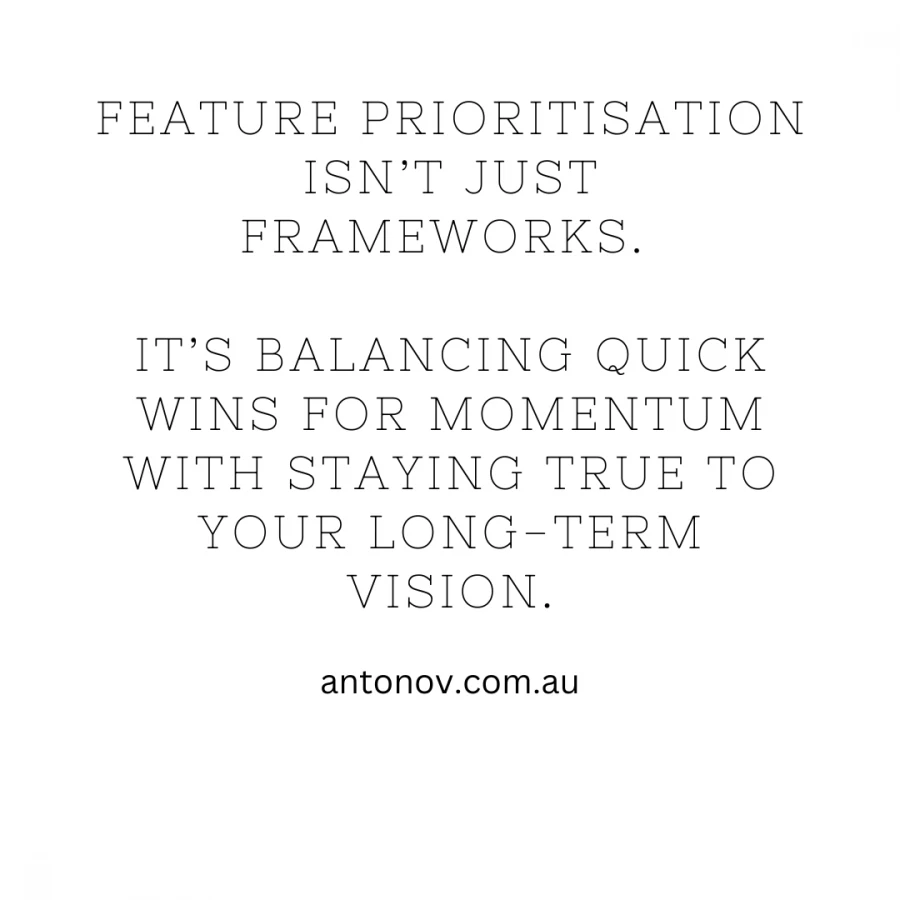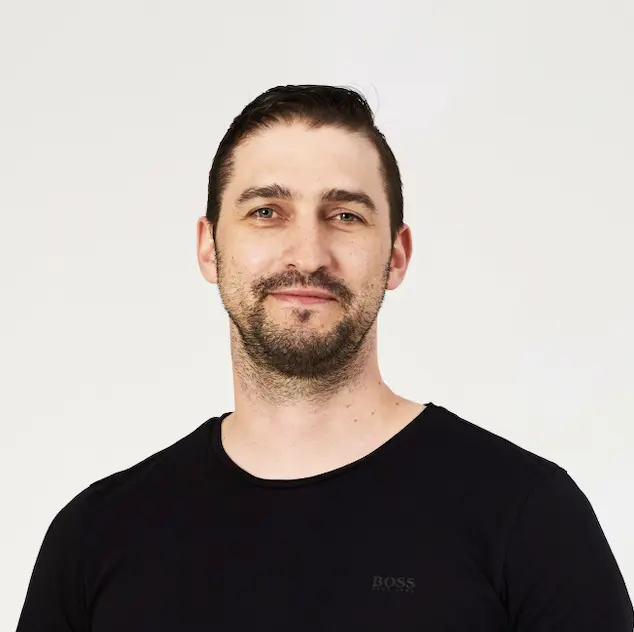I'm a father of three from Sydney, a Product Director and a Product Coach. I write about product management and run the Product Manager community.
Subscribe to receive digest emails (1 per month).
Info
Posts with Product Management tag.
-
Product Managers own the full lifecycle - strategy, discovery and delivery. Product Owners focus narrowly on Agile delivery. Splitting these roles fragments accountability and muddies product development.
True impact comes from roles with full ownership. -
Engineers love clarity. The most important problem defines the mission.
A disjointed list of tickets signals confusion, while a vague objective offers no direction. Great work emerges when the goal is clear, focused and free of jargon.
When the problem is precise, teams know exactly where to aim. -
Not every team needs a dedicated PM. Someone is already handling the PM work informally. It's not complex.
Eventually, though, clear ownership becomes unavoidable. Is an individual contributor juggling alignment, communication and strategy alongside their core work? Or is it time to delegate those responsibilities to someone focused entirely on them?
The decision shapes how the team prioritises and executes. -
A great product isn't just a checklist of requirements. It's built by understanding the customer's problem and why it actually matters.
Don't just follow instructions. Look deeper. Ask why. Question the logic.
The best solutions come from people who do a bit of detective work, not just execute. -
Side projects teach product management faster than any course.
Finding a problem, crafting a solution and marketing it sharpen critical skills. You learn to balance creativity with practicality and adapt to real-world feedback.
Hands-on experience builds stronger product managers. -
Big ideas need action to become real.
Break them into small, clear steps. Each win builds momentum and keeps you moving.
Perfection doesn't matter - progress does. Test, learn, improve, repeat.
No one will remember your first crappy step but they will when you cross the finish line. -
Great ideas are crafted, not found.
They come from clear problems, real insights, diverse perspectives and bold inspiration. Ideation sessions - prep, sketch and develop. Turn this mix into better solutions and stronger buy-in.
Prep sets the stage. Sketching sparks creativity. Development refines ideas into actionable next steps. Keep it sharp and ideas will shine. -
Removing a feature signals a mistake. Few people feel comfortable admitting that.
This hesitation keeps bad features alive. Teams cling to them, fearing the optics of walking back a decision. But doubling down on something that doesn't work costs more in the long run - time, energy and user trust. Recognising when something doesn't fit and cutting it isn't failure. It's progress.
Users notice when products improve. Removing what's broken clears space for what works. -
The exec team was drifting, priorities misaligned, goals scattered. With OKRs, we trimmed 50 key results to 15, forcing clarity on what mattered most. The tough trade-off conversations exposed clashing perspectives but created alignment. Had to be done.
-
In product management, it's tempting to move fast and break things. Sometimes, that works.
But moving with purpose works better. It means focusing on what matters, making smart choices, and building something valuable. Speed without direction leads to wasted effort. Purposeful action builds progress that lasts.
Fast fades. Purpose wins. -
Saying no is a leadership skill.
It's not about rejecting ideas, it's about protecting focus. When everything feels important, nothing is. Saying no clears space for what truly matters - what drives impact, not just activity.
Yes, it will sting. People will take it personally. But prioritisation isn't about popularity; it's about progress.
Every “no” to distractions is a “yes” to momentum. -
Bold ideas unlock progress.
When crafting new products or features, it's easy to focus on safe, incremental improvements. These solutions feel achievable and practical but they rarely break new ground.
Adding a bold concept into the mix forces the team to think beyond limitations. Even if the daring idea doesn't make it to launch, it creates a spark. It pushes boundaries, reshapes how problems are viewed and reveals opportunities overlooked in safer designs.
A bold solution isn't just a backup plan. It's a catalyst for better work. -
Trust between a founder and their first Head of Product defines whether a startup scales or stalls.
Founders often start as the Head of Product, driving vision, roadmaps and hiring. But as a company grows, splitting attention across fundraising, culture, operations and strategy leaves product leadership exposed. Bringing in a Head of Product isn't just inevitable - it's essential. The challenge is doing it without breaking the momentum or diluting the founder's vision.
Alignment is the foundation. A great Head of Product doesn't just execute - they embody and challenge the founder's instincts, building scalable systems around them. -
A team doesn't always need a dedicated product manager.
In startups, founders often take on this role naturally, using their deep understanding of the market and their vision for the product.
In larger companies, if the team already has a strong handle on strategy, data and market needs, they can absolutely operate without a formal PM. However, someone still needs to take charge of the product function - making prioritisation decisions clear and aligning the team around common goals. -
Feature prioritisation isn't always about frameworks like ICE (Impact, Confidence, Effort), Kano or MoSCoW.
Sometimes, it's about building momentum - creating buzz, lifting your team's morale, staying ahead of competitors or even strengthening internal relationships.
The challenge is finding the balance between chasing these quick wins and staying true to your long-term vision.

-
The Most Important Skill for Product Managers
As my product management career has progressed, my perspective on the most important skill has changed. Early on, I thought it was all about speed - getting things done fast. Later, I believed strateg... Read more -
A playbook for product managers and tech leads who want faster innovation and deeper team buy-in.
Protecting Discovery: A Playbook for Product Managers
Audience: Early-career and seasoned Product Managers, Product Owners, and cross-functional leads who want to lift team creativity and ship products customers rave about.
Why Rushing to Solutions Backfires
- Solution-first thinking kills curiosity. The instant you pitch a fix, the room defaults to critique rather than exploration.
- Creativity needs slack. When discovery is compressed, edge cases, fresh perspectives, and customer nuance vanish.
- Ownership drives quality. Teams fight for ideas they helped shape; they resist ideas handed down.
Common Scenarios Where Discovery Gets Short-Circuited
Situation Typical Reaction Better Move Stand-up uncovers a blocker PM offers a quick workaround Pause: ask “What does great look like?” Stakeholder demands a feature PM drafts the PRD overnight Run a lightning discovery workshop Designer shows early mock PM requests tweaks Invite engineers to stress-test assumptions
The Discovery-First Framework
1. Frame the Problem, Not the Fix- Clarify the friction: user pain, market gap, or workflow snag.
- Share constraints: budget, timeline, regulatory, tech stack.
- State the desired outcome: measurable impact or customer behaviour change.
2. Hold the Space- Use open prompts:
- “Where does this break for users?”
- “What edge cases worry you?”
- Embrace silence - ideas bloom in the gap.
- Capture themes, not verdicts.
3. Invite Diverse Voices- Engineers for feasibility checks.
- Designers for journey mapping.
- Sales/Support for frontline insights.
- Reference models like Atlassian's Team Playbook “Discovery Play” for facilitation.
4. Convert Insights into Experiments- Draft thin-slice prototypes or assumption tests.
- Prioritise by risk vs. learning value.
- Track outcomes in a shared dashboard (e.g. Productboard, Jira).
5. Guard the Vision, Not the Path- Keep goals visible: OKRs, North-Star metric.
- Let the team iterate on execution details.
- Step in only to re-align on purpose, not on pixel placement.
Quick Reference: Discovery-Boosting Questions
- “What's the riskiest assumption here?”
- “If we had unlimited time, what would we explore first?”
- “How might a power user break this?”
- “Which customer quote captures the pain best?”
-
This is for: Founders, Product Managers (PMs) and Product Designers (PDs) in fast-moving tech teams who ask, “How do we stop duplicate work and ship faster?”
TL;DR
Role clarity is oxygen. Let PMs own direction and PDs own experience. Protect calendars, write before debating, adjust volume by phase and track one metric that matters. Ship faster, sleep better.
1. Draw the Line Early
Product Manager (PM)- Core focus: market and viability risk
- Typical questions: “Will people pay for this?” “Does it move the North-Star metric?”
- Key output: one-pager covering purpose, success metrics and trade-offs
Product Designer (PD)- Core focus: usability and desirability risk
- Typical questions: “Can customers complete the task?” “Where do they stumble?”
- Key output: clickable prototype showing flow, copy and edge states
On your next discovery call, let the PM capture market insights while the PD sketches pain-point journeys. They'll walk away owning different artefacts - no rewrites, no turf wars.
2. Guard the Calendars
Red flag: PM trapped in Figma tweaking icons.
Red flag: PD buried in cost–benefit spreadsheets.
Fast filter:- If the task changes product vision, it belongs to the PM.
- If the task changes product surface, it belongs to the PD.
This discipline frees the roadmap and keeps creative energy high.
3. Write First, Talk Second
- PM posts a succinct one-pager to Slack outlining problem statement, success measures and known constraints.
- PD replies with a Figma link showing interactive flow, micro-copy and empty-state behaviour.
- Only then schedule a 30-minute debate. Decisions lock in, iteration time halves.
4. Phase-Based Volume Control
- Framing / Discovery – PM's voice dominates; market-sizing memo appears.
- Ideation & Prototyping – PD leads; high-fidelity Figma frames drop.
- Build & Polish – PD still loudest; design-system tokens freeze.
- Launch & Iterate – PM turns the volume back up; KPI dashboard lights up.
5. Share One Scorecard
Choose a single, public metric - activation lift, task-success rate or first-week retention. Both crafts pull the same lever, killing silos and politics.
6. Outcomes You Can Expect
- 25–40 % faster time-to-decision (anecdotal data from five Aussie SaaS teams).
- Higher designer morale: fewer context switches, deeper craft.
- Sharper product bets: PMs stay market-obsessed, avoiding “feature museum” creep.
Recommended Tools & Rituals
- Figma for rapid prototypes (PD).
- Miro/FigJam for story mapping (shared).
- Amplitude or Mixpanel for the single metric (PM).
- Weekly 15-minute “Line-Check” stand-up: confirm who owns which decisions this sprint.
-
Dedicated QA creates more problems than it solves.
When a dev team owns quality, accountability stays in the right hands. Bugs are fewer, fixes are faster and processes tighten.
Introducing dedicated QA shifts that balance.
Developers grow complacent, relying on testers to catch mistakes. Tools diverge, creating inefficiencies. QA often duplicates what devs should already handle.
Quality isn't a separate role. It's a shared responsibility embedded in every line of code.

-
Product Management FAQs
Product managers decide what to build next. They are accountable for the overall success of the product.
Product Managers drive the vision, product strategy, user experience, execution, and success of... Read more
Feel free to reach out: [email protected].
